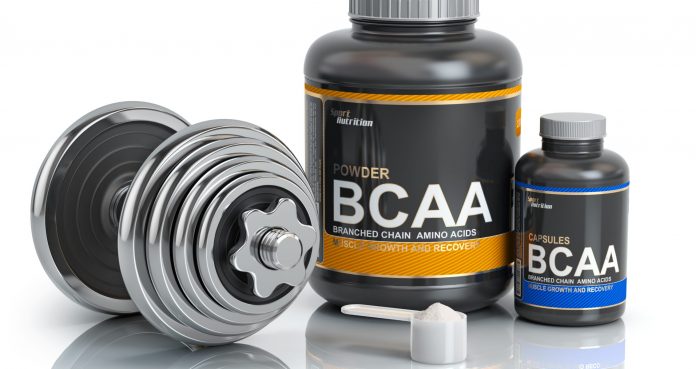
Don’t let the old way of thinking turn you away from a great supplement for muscle growth.
Much debate has been had over the use and benefits of BCAAs and EAAs in the world of bodybuilding and sport. Studies and research have looked hard into the effectiveness of these products as a way to boost athletic performance and the necessity over others. With confusion running high around the topics of BCAAs and EAAs, it is more than understandable that you would gloss over them and move down the line. Why buy what you don’t understand?
BCAAs have long sat on shelves with great popularity for athletes of all kinds, but as more and more studies come out on these products, many people question if they are really worth it. With so much flip-flopping, it can be difficult to make that choice on something that could ultimately boost your training to a new level. It is important to know the differences between the two and the benefits surrounding them for you to make an informed and educated decision on which BCAAs supplement or EAAs supplement to buy.
Let’s dive into the differences between these two vital components for growth, both EAAs and BCAAs. What we will find is that in order for protein synthesis to begin, and ultimately that much sought after development to be fully completed, we need both BCAAs and EAAs for this to take full effect. Let’s jump into what they are, how they can help you, and why you should be taking them as part of your workout to really maximize all of your goals and that better bodybuilding physique you work so hard for.

What are BCAAs?
Branch chain amino acids (BCAAs) are essential amino acids (EAAs). While this may seem confusing, the differences come from their chemical structures. To start, amino acids are organic compounds that provide the foundation for protein and serve as building blocks. Protein helps to build muscle and also aid in recovery, so amino acids are more than important when it comes to seeing gains in the gym.
There are 20 amino acids that make up protein, but of that 20, only nine are considered essential amino acids (EAAs). They include: histidine, isoleucine, lysine, leucine, methionine, phenylalanine, tryptophan, threonine, and valine. Three of these essential amino acids are branch chain amino acids (BCAAs) being isoleucine, leucine, and valine. What separates them from the rest is that their side chain branches out allowing for a different metabolic rate.
BCAAs are found in foods that contain large amounts of protein and what the supplement can do is stimulate protein synthesis and increase mass to really maximize all of those gains you’ve worked so hard for while pumping you with leucine, isoleucine, and valine. When you exercise, your body uses your glycogen stores for energy and as your fuel source starts to run low, the body turns to proteins and amino acids for that boost. BCAAs are a quick way to prevent fatigue and offer that much needed better energy boost.
Benefits of BCAAs
BCAAs are known to have many benefits for the body. Leucine, one of the three BCAAs, can stimulate muscle protein synthesis by activating certain pathways in the body (1), resulting in the production of muscle. However, when the muscle breakdown exceeds muscle protein synthesis, your body starts to lose that hard work you desperately fought for and BCAAs can help with this. The balance of muscle protein breakdown to muscle protein synthesis must remain stable for it determines how much muscle you put on (2). So while BCAAs stimulate that muscle protein synthesis, it will prevent muscle breakdown and allow for those gains to better show as well.
Along with the pros of packing on the muscle, BCAAs are known to aid in recovery and decrease muscle soreness (3), allowing for ample recovery to keep you going strong. Reducing damage will further development and not pull you away from that valuable training. BCAAs have been shown to also reduce fatigue during exercise. While so many of us experience exhaustion at some point during our workout, BCAAs improve mental focus and convert certain brain chemicals to reduce fatigue (4), ensuring you stay at that high level. The benefits of BCAAs are evident, but the debate over them never seems to let up.

Why EAAs Are Important
While BCAAs may seem like that catalyst to boost protein synthesis, prevent muscle deterioration, and ultimately lead to insane development, you cannot forget about EAAs. Without EAAs, BCAAs alone cannot actually drive progress. Although BCAAs will do their best to prime the muscle to grow, you need EAAs to build actual tissue and all nine essential amino acids need to be present for muscle protein synthesis and energy to fully take place (5).
This is crucial to note for those looking to put on more muscle mass, for BCAAs alone will not get the job done. EAAs are considered essential because your body cannot produce each essential amino acid. Only the proper consumption of better nutrients can ensure you fill your body with the right amount of EAAs and people have started to push this supplement for that reason.
The best option you could get is an essential amino acid supplement that contains a high amount of EAAs with the added bonus of extra BCAAs. This will ensure that proper growth becomes a reality and you start to really see an increase in your size and muscle mass. By combining both into one supplement you will save money and the convenience of multiple supplements which can just be an all around pain for you. The truth is you must have both BCAAs and EAAs, so make sure you are getting both with a great supplement that won’t pump you with anything other than the essentials that you get.
Should You Take Them
It seems as though both are needed to ensure you make gains in the gym. BCAAs will activate protein synthesis and reduce muscle fatigue to ensure you stay strong and complete a training session at maximum capacity. EAAs come to their aid by providing the right benefit to actually see those muscles come to fruition. While these can be helpful for that added benefit in the gym, they aren’t entirely necessary. While many people do still use them, it is critical to recognize that getting these nutrients from whole foods is always better than getting them strictly from supplements and other forms of supplementation.
With the right diet, you can already have an abundance of both in your body. Most protein rich foods have a high percentage of BCAAs in them. Foods like eggs, salmon, peanuts, and cheese contain high amounts, and if you are one to take protein powder, you get a healthy dose in that as well. To save money and see big gains occur, your grocery list may be enough to kick start your muscle regiment into gear. If you do feel as though you must take this supplement to enhance your gains and keep you working harder in the gym, then look into quality brands and see what works for you. It may take some trial and error, but you will ultimately find one that will work wonders for you.

Conclusion
A lot of debate is had around taking BCAAs and EAAs as supplements and it all comes down to the individual and what they seek to accomplish. While studies and research show many pros in taking these two, others show they may not be as useful as original thought. If you already run a strict workout regiment and have a solid diet, continuing with whole foods offer plenty of advantages to boost performance. Meeting your protein intake and thriving in the gym offer enough components to see that sought after growth. If you feel comfortable and want to experiment with BCAAs and EAAs, they do have the ability to help with muscle growth, so look into reputable brands and give them a try. While they can certainly be beneficial, you may already have what you need to succeed without them for your pre workout, intra workout, or post workout muscle building goals that stimulate muscle and tackle all of your protein needs.
See our Top Rated BCAA Supplements. Also, see our Top Rated Most Effective BCAA Supplements.
Let us know what you think in the comments below. Also, be sure to follow Generation Iron on Facebook, Twitter, and Instagram.
*Images courtesy of Envato
References
- Blomstrand, Eva; Eliasson, Jorgen; Karlsson, Hakan K.; Kohnke, Richard (2006). “Branched-chain amino acids activate key enzymes in protein synthesis after physical exercise”. (source)
- Tipton, Kevin D.; Hamilton, D. Lee; Gallagher, Iain J. (2018). “Assessing the Role of Muscle Protein Breakdown in Response to Nutrition and Exercise in Humans”. (source)
- Howatson, Glyn; Hoad, Michael; Goodall, Stuart; Tallent, Jamie; Bell, Phillip G.; French, Duncan N. (2012). “Exercise-induced muscle damage is reduced in resistance-trained males by branches chain amino acids: a randomized, double-blind, placebo controlled study”. (source)
- Newsholme, Eric A.; Blomstran, Eva (2006). “Branched-chain amino acids and central fatigue”. (source)
- Borsheim, Elisabet; Tipton, Kevin D.; Wolf, Steven E.; Wolfe, Robert R. (2002). “Essential amino acids and muscle protein recovery from resistance exercise”. (source)
